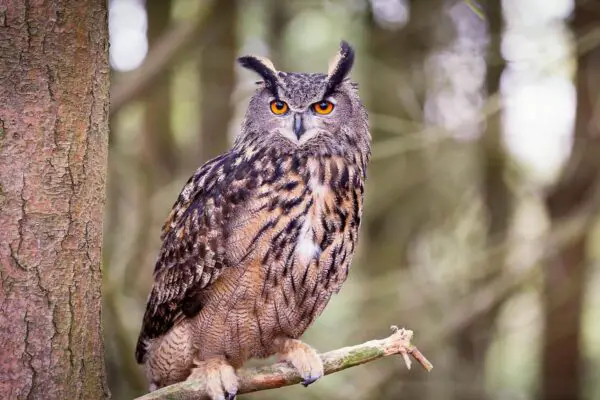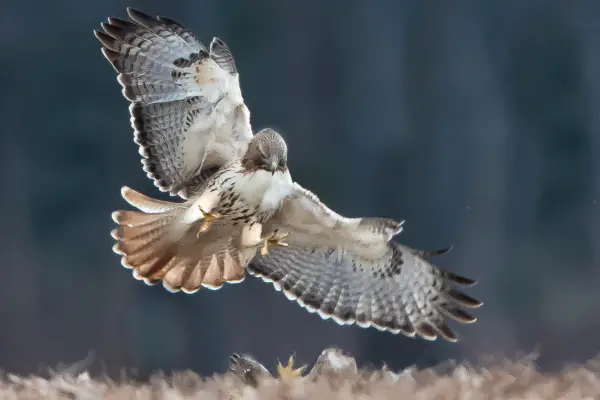The sound of an owl hooting at night is a unique and captivating experience. It brings feelings of mystery, excitement, and sometimes fear. But have you ever wondered why owls hoot? Is it a form of communication?
Owls hoot for various reasons. One of the main purposes of these calls is to communicate with other owls of the same species. By hooting, owls convey that they have claimed a specific territory and that other owls should stay away. Additionally, hooting can serve to attract a mate and strengthen the bond between a pair of owls.
Owls exhibit a wide range of vocalizations, including whistles, chirps, hoots, and grunts. The iconic hooting sound is famously associated with common American owl species like the great horned and barred owls, although other owl species also produce similar calls.
Let’s explore more about the reasons behind owl hooting and when they do it. You might find that it changes your perspective on these enigmatic nighttime hunters.
Are All Owls Hooting Birds?
While many people link owls with hooting, these birds can create a diverse array of calls. Different owl species have their unique range of sounds for various purposes, and not all owls are capable of hooting. Some of these sounds are quite distinct from the deep, resonant hoots we commonly associate with owls.
Owls can produce an assortment of peculiar sounds, from high-pitched screams to non-vocal snapping sounds created by their bill movements. For instance, barn owls emit an eerie hissing shriek, while eastern screech owls produce a whinny that resembles a horse’s neigh.
When Do Owls Hoot?
Owls are creatures of the night, meaning they are most active and vocal during nighttime hours. They tend to do their calling in the darkness. The timing of their vocalizations often corresponds to the period leading up to their breeding season, although this varies among owl species. For instance, snowy owls start nesting in late fall, while great horned owls mate during the middle of winter.
Some owls begin making sounds even before they hatch, possibly to get their mother’s attention while she’s incubating the eggs. Younger owls don’t usually produce the same hooting calls as adults, but they make various sounds as they grow up. For example, great horned owls begin true hooting at around one year of age.
Also Read: Species of Owls in Texas
When Is the Common Time to Hear Owls Hooting?
Owls tend to be most vocal shortly after sunset and right before sunrise the next morning. While their calls can be heard throughout the night, they may call consistently from dusk till dawn. Research on eagle owls in Spain showed that these birds were more active vocally on moonlit nights when their white throat patches were more visible. Since great horned owls share a similar throat patch and belong to the same genus, they might also prefer calling when the moon is visible.
Do Owls Hoot During the Day?
Usually, owls are heard hooting after dark, but there are exceptions. Barred owls, for instance, are quite vocal during daylight hours. However, their characteristic hooting calls are more commonly heard after sunset. Sometimes, what might seem like an owl call during the day could actually be diurnal birds like mourning doves or rock pigeons, producing low-pitched calls that can be mistaken for owl hoots.
What Do Owl Hoots Signify?
Owls hoot to communicate with other owls of their species. These calls can serve to attract fellow owls or establish territorial boundaries. Continue reading to learn about the meanings behind various types of owl calls.
Why Do Owls Hoot?
Territorial Hooting Owls hoot to mark their territory. When they hoot, owls are telling nearby owls that they are still around and ready to protect their space. If other owls or intruders are heard or seen in their territory, the hooting owl might fly in and respond aggressively.
Courtship Hooting Owls also hoot to attract a mate and strengthen their bond. They often hoot more before they start breeding. The hoots can be different for males and females. For instance, male and female spotted owls have different hoots and whistles when they’re trying to mate.
Why Do Owls Hoot in Winter?
Winter can be challenging for bird watching, especially up north where many birds only stay for part of the year. But it’s a good time to see owls. Some owl species are most vocal during breeding season, like the great horned owl. These owls breed in winter, which is unusual for birds. They take care of their chicks for months, so it’s smart for chicks to start finding food when it’s warmer and food is easier to find.
Barred owls also breed early. They often start hooting in February with their unique ‘Who cooks for you? Who cooks for you all?’ call.
Owl Hooting Spiritual Meaning The sound of an owl hooting on a dark night has different meanings around the world. Some think it’s a bad sign, while others believe it brings good luck. Certain Native American groups revere owls, thinking they guide the dead to the afterlife. This could be why some people fear owls as a bad omen. Others see owls as a symbol of wisdom, even though they might not actually be the smartest birds.
Final Thoughts
Owls hoot at night because that’s when most owl species are most active. They hoot for various reasons: to protect their territory, scare away predators, and communicate with their mates.
The hooting of owls can vary depending on why they’re making the sound. When they’re marking their territory, their hoots are usually louder and more continuous. If they want to scare off predators, they might screech or shriek instead.
During mating, owls often engage in duets, with the male and female taking turns hooting in response to each other. Mated pairs even develop their own unique “language” that only the male and female of that pair understand, distinguishing them from other owls in the area.
Sometimes, you might hear owls hooting during the day. This is because some owl species are active both at night and during the day, and they may hunt in daylight. There are even owl species that are primarily active during the day and rest at night.
By spending time listening to owls, you can learn to recognize their different sounds and maybe even identify different owl species by their calls.
Frequently Asked Questions on Owl’s Hooting
Do owls scream?
Owls can make unexpected sounds. Great horned owls scream when protecting their nest, and the barn owl’s screeching call can startle those who are easily frightened.
Do other birds hoot?
A few other birds can sound similar to owls. The mourning dove is a common bird that can sound a lot like a hooting owl, but it usually calls during the day.
Which owl hoots 4 times?
The great horned owl has a distinctive hooting call that often sounds like four syllables. This call is often described as hoo-h’HOO-hoo-hoo, but the number of hoots can vary in each call.
Which owl hoots 8 times?
The barred owl, commonly found in mature forests, has a unique call that sounds like ‘who cooks for you? Who cooks for you all?’
How far can you hear an owl? Owl calls can travel long distances on quiet, cold nights. Some researchers have even claimed to hear snowy owl calls from nearly seven miles away, though that might be a bit exaggerated!






